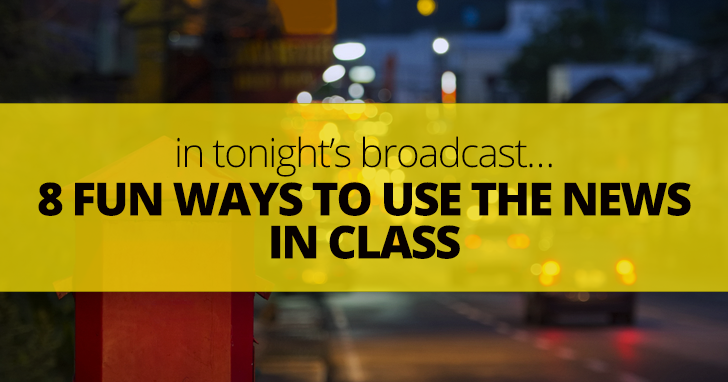Creative Current Events: 5 New Ways to Use Todays’ News in Class


The nightly news. There’s one thing that’s true about most human beings. We want to know what is going on. But the news is good for more than satisfying our morbid curiosity. It is a great resource for the ESL classroom. Both news broadcasts and print news can be used in creative and interesting ways to engage students learning English. Try these eight activities for bringing world events into your classroom.
News programs are great sources of information. In fact, news articles pride themselves on being concise and information packed. Have students take information they see in a news program and put it to use in this writing assignment. Start by having students listen to a news program or segment and take notes on that story. They should then use the information they gathered to write a newspaper article. Students should make sure that the article answers who, what, where, when, why, and how as every good article should, preferably in the first paragraph. Also, newspaper articles tend to be short and to the point, so encourage students to keep paragraphs small and stick to the facts. If you like, have each of your students listen to a different news segment (available online) and then compile all of their articles into one class newspaper.
Do your students like to perform for their classmates? If so they might enjoy doing a mock newscast in the classroom. It is not uncommon for a news program to have two anchors, a weather person, and a sports reporter in each broadcast. Break your students into groups of four and have them choose the roles they will perform in their broadcast for the class. Then show your students an actual news program that they can use for inspiration and as a source of information. Have students pay particular attention to how the speakers pass center stage to each of their coworkers. If you like, take a minute after the program to write down the phrases the broadcasters used such as the following: and now back to you, let’s see what Matt has to say, and what weather are we looking at for the weekend, Marv. Encourage your students to think of other ways they might direct the viewers’ attention to another person in the broadcast or transition from one topic to another, and add those to your list. Give students plenty of time to work on their own. Then give each group five to ten minutes to present a skit to the class featuring themselves as the newscasters giving whatever information they think the class needs to hear.
Gather ten newspaper article or online articles for this reading activity and separate each headline from the news article that goes with it. Mix up the headlines and articles and post them in random order on an empty bulletin board or poster board in your room. Number each headline from one to ten and each news article from a to j. Then have students read the headlines and the articles and determine which ones go together. Follow the activity by having students not the similarities between the headlines and then writing some alternate ones for the articles they read.
The news is a great source for showing opposite opinions on a given topic. Show your students several news clips that deal with the same topic, and be sure that the information is presented from different perspectives. (Hint: try looking at news segments from different television channels.) Have students take notes on the support each side gives for its opinions. After they have seen both sides of the issue, encourage students to formulate their own opinions on the matter. Then hold a classroom debate. Have your students divide themselves according to which side of the issue they support. Then have each group select one person to be the speaker for their group. Hold a debate between the two speakers, allowing them to consult with their group at any time for what to say to their opponent.
News segments make great and simple listening comprehension activities. One thing that makes newscasters particularly good for classroom presentations is their seeming lack of accent. Newscasters speak in what is called Newscasterese – a neutral accent which sounds at home in any area of the country. This eliminates the confusion or stigma that can come from regional accent or personal speech style that other materials you select for class might have. Play a clip for your students, and then ask them several questions about the details presented in the segment.
Many news articles contain statistical or demographic information, information that can easily be converted into a visual. Divide your students into groups of three or four, and give each group an article that includes some such information. Then ask your students to convert the pros information into a graphic, such as a bar graph, pie chart, or line graph. Once groups have finished their visuals, have them tell their news story to the rest of the class using their graphs as visuals during their presentation. This is a particularly good activity for students who might be better at understanding what they read than expressing themselves in words since much of the information is communicated through a visual.
The world news is a great way to get students thinking about what is happening throughout the globe. Give students a world map or post one in your classroom. Show students one or more segment from the world news, and have them place a pushpin on the map where each story is happening. Then have students string a piece of yarn from the pushpin to the margin of the map where they should write an appropriate title for the news story and a one or two sentence summary of it. If you like, keep adding stories to the map over the course of a month and see which area of the world has the most newsworthy stories.
This is a fun game that will also get your students learning new vocabulary. Have students list the letters from A to Z on a sheet of paper, and then have them watch a news program or read a newspaper article. As they listen or read, students should write down one adjective starting with each letter of the alphabet that they encounter. No student will be able to fill in every letter from A to Z, but after watching the program, have students share what they wrote. Make sure you list each word on the board so your students can see them all and fill in any spaces they had blank on their lists. As you do, review any adjectives that your student are not familiar with. If you like, follow up by having students use these words in your favorite vocabulary exercises.
Try using the news in your class today and get your students in touch with the outside world as they work on their internal language skills.